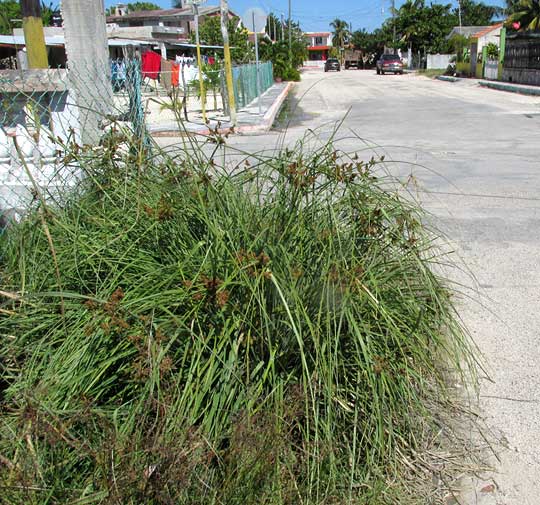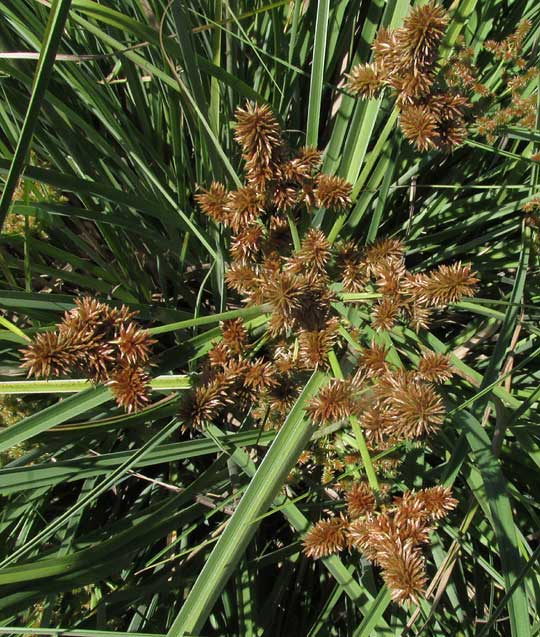Excerpts from Jim Conrad's
Naturalist Newsletter
from the November 2, 2014 Newsletter issued from Río Lagartos, on the Yucatan Peninsula's northern coast (~N21.60°, ~W88.16°), Yucatán state, MÉXICO
RUSTY FLATSEDGE, YUCATAN STYLE
During our recent stay in arid southwestern Texas we got to know the Rusty or Fragrant Flatsedge, CYPERUS ODORATUS. You can see the dinky little Texas plant we profiled at www.backyardnature.net/n/h/cyperus2.htm.
I certainly didn't have that plant in mind when I set out to identify the robust, chest-high heap of vegetation shouldering its way onto the street at the corner of the lot where I live now in Río Lagartos, shown below:

Below, you can see how the spikelets of our Río Lagartos plant cluster in bristly little heads in a compound inflorescence with each bunch of heads bunched together on their own stem, or ray. This is the same configuration employed by our little Texas plant, so when I saw this here, I figured our streetside plant might belong to the same genus as our Texas Rusty Flatsedge, the genus Cyperus, but that's a big genus so even still I didn't make a connection between the two plants.

But then I looked even more closely at our Yucatan spikelets, saw how they were roundish in cross-section instead of the usual flattened way, and that's unusual for the genus Cyperus, though it's exactly the way our Texas Rusty Flatsedge was. Now my brain started percolating a little. You can see the spikelets below:

The short story is that my big, bushy plant here in Río Lagartos is in fact regarded as the same species as the ankle-high little herb we profiled earlier in Texas. Working it all out in keys of the online Flora of North America, I could hardly believe it, so I teased some achene-type fruits from some spikelets, and they turned out to look exactly like achenes of Rusty Flatsedge, as shown below:

The Flora of North America grants that Rusty Flatsedge is an "exceedingly variable" species with stems up to 130cm tall (4.3ft). Also, it's very widespread, occurring just about everywhere except really cold areas and in Europe, so much variation is to be expected. The spikelets of our Yucatan plants appear to be more numerous in the heads, and more closely packed together than most illustrated on the Internet, but a few plants in hot tropical regions do look like ours. Also, the Flora of North America says that "Numerous segregates have been named, some of which may deserve recognition when the species is studied in detail worldwide." In other words, we may actually have something different here from what's commonly seen in North America, but so far taxonomists haven't figured that out yet.
Anyway, I'm glad to document what we have here for those future folks who will study this Rusty Flatsedges " in detail worldwide." One last detail to mention to them, when they find these words, is that I find Rusty Flatsedge growing in town, as shown in our picture, but not in more natural areas outside of town.